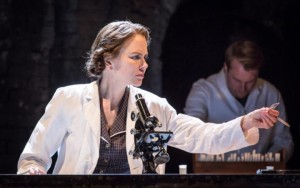17 September 2015
PHOTOGRAPH 51
Noel Coward Theatre, London WC2
by Neil Tidmarsh
In 1963, the Nobel prize for physiology or medicine was awarded to Francis Crick, James Watson and Maurice Wilkins for the discovery of the structure of DNA ten years earlier. Anna Ziegler’s play ‘Photograph 51’ is about a fourth scientist, Rosalind Franklin, whose x-ray photograph of DNA inspired Watson’s crucial, break-through vision of a double helix. The play implies that Wilkins, Watson and Crick more or less filched her work and didn’t give her any credit for it. It’s a campaigning piece, seeking to claim her rightful share of the Nobel glory and fighting for a just recognition of her achievements.
The play is brave enough to present her as difficult and abrasive, though Nicole Kidman manages to make her dignified and sympathetic as well – a fine performance, all the acting is impeccable. But there isn’t a huge amount for Kidman to work on. There isn’t much to the character of Franklin; she doesn’t have a life outside science; she hardly exists outside the laboratory. The script does give Franklin a tragic awareness of her isolation but the character doesn’t really develop or change. She is literally dying (she died at the age of 37, probably a victim of the x-ray photography’s radiation) but she is presented as metaphorically lifeless as well; there are references to ‘A Winter’s Tale’, in which we are (I think – the device is a little too literary and abstract) intended to see Franklin as the supposedly dead Hermione, the apparently lifeless statue struggling to come alive. Indeed, the play as a whole is rather static. There are a lot of monologues delivered straight to the audience – we are told (as in a radio play) rather than shown (as in a stage play). And the central relationship – the personality clash between Wilkins and Franklin – doesn’t change or evolve. It’s established as dysfunctional at the start, and it stays dysfunctional.
Frustratingly, the play touches on the ironies of her death (the pursuit of the secrets of life sowing the seeds of death) without fully exploring their dramatic possibilities or metaphorical, mythical resonances (Franklin as Prometheus?). Perhaps that’s a problem of a campaigning piece – other interesting aspects of the story have to be ignored as distractions. Could there be, for instance, an interesting moral dilemma in Wilkin’s transgression; perhaps Wilkins rather than Franklin was Prometheus – theft is theft, but was Prometheus justified because he was stealing fire from those who didn’t appreciate what it was or what it could do for mankind? Neither does the play’s argument have space for much subtlety – the English characters are all pompous and untrustworthy buffoons: the American characters are all focused and hard-working.
A problem with a play dealing with real people, real events and real-life controversies is the nagging question at the back of your mind ‘Yes, but was it really like this? Is this what really happened?’. It takes a certain mental effort to silence that question and to experience and enjoy the play as a play, to remind yourself that it is a play and not a documentary film, that what matters is the integrity of the playwright, director and actors with regard to being true to their art. That’s the only kind of truth that matters. Any other kind is irrelevant. At least while you’re in the theatre.
This week, an article by Matt Ridley (author of ‘Francis Crick; Discoverer of the Genetic Code’) in the Times took issue with a number of the play’s claims. He points out that the Nobel rules insist that the prize can only go to living people; Franklin couldn’t have been nominated with Crick, Watson and Wilkins because she died in 1958. Moreover, he says that it is generally agreed that if she had been alive in 1962 she would almost certainly have been jointly nominated for the chemistry prize with Wilkins, while Crick and Watson would have been nominated for the medicine prize. My own copy of ‘Chambers Biographical Dictionary’, almost twenty years old now, goes as far as to describe her as a ‘posthumous Nobel Prize winner’! So much for lack of recognition – quite the opposite.
As for the ‘theft’ – the play implies that Gosling ‘slipped’ photograph 51 to Wilkins behind Franklin’s back soon after it was taken; Ridley points out that in fact it came into Wilkins’ hands quite legitimately when Franklin left King’s College and handed the DNA project back to him. Perhaps Wilkins shouldn’t have then shown it to Watson at Cambridge, but that was nine months after photograph 51 had been taken; Franklin had had almost a year to realise the photograph’s significance but had apparently failed to do so, and had then moved on from studying DNA at King’s to studying the tobacco mosaic virus at Birkbeck; Watson saw the photograph at that point and realised its significance straight away.
Photograph number 51 ‘screamed “double helix” to Watson’. It was the best photograph to come out of Rosalind Franklin’s x-ray photography lab. But Matt Ridley points out that Rosalind Franklin didn’t take it. Raymond Gosling took it. What? The graduate student? The assistant? The useless Bertie Wooster character in the play? Yes. He had been taking photographs of DNA in hydrogen gas for more than a year before Franklin joined the project; under Wilkins, he had already taken the photos that had first shown that DNA had a regular structure. But he was completely overlooked by the Nobel committee and remains unrecognised by history (my ‘Chambers Biographical Dictionary’ doesn’t even mention him).
Anyone out there willing to write a script about the scandal of Raymond Gosling’s lack of recognition? Only make it a documentary film, please. Not a stage play.


